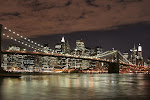 Turns out that the two state sides of the border are very different on Assateague and are searated by a horse-proof mile-long fence--that extends into the ocean. On the Virginia side, the herd is kept at 150 horses and for most of the year they are wild--and hard to see, especially this time of year. It seems that the horses know that at the end of July the Penning round-up happens and all the Virginia side horses are rounded up and forced to swim across to a point on Chincoteague Island, where they are put into corrals and the young foals are sold away from their parents and herd. After the spectacle, the remaining horses are forced back across the water to the Assateague Island side to be left alone until the following year. Because of this traumatic episode, the horses are extremely hard to find and see.
Turns out that the two state sides of the border are very different on Assateague and are searated by a horse-proof mile-long fence--that extends into the ocean. On the Virginia side, the herd is kept at 150 horses and for most of the year they are wild--and hard to see, especially this time of year. It seems that the horses know that at the end of July the Penning round-up happens and all the Virginia side horses are rounded up and forced to swim across to a point on Chincoteague Island, where they are put into corrals and the young foals are sold away from their parents and herd. After the spectacle, the remaining horses are forced back across the water to the Assateague Island side to be left alone until the following year. Because of this traumatic episode, the horses are extremely hard to find and see. That somewhat sad story on the Virginia side is contrasted with the Maryland side, where the horses are left alone all year to live as they would in the wild, except that all mares are shot with a dart that limits them to 1 foal per lifetime. As a result the horses here do not fear humans at all and live amongst them--walking next to campers, seemingly not at all intimidated by humans, unless, of course, they try to touch them. Imagine what would happen if someone actually tried to put a saddle on and ride one! The visitors center had photos of people's backs where the horses had bitten them!!!
That somewhat sad story on the Virginia side is contrasted with the Maryland side, where the horses are left alone all year to live as they would in the wild, except that all mares are shot with a dart that limits them to 1 foal per lifetime. As a result the horses here do not fear humans at all and live amongst them--walking next to campers, seemingly not at all intimidated by humans, unless, of course, they try to touch them. Imagine what would happen if someone actually tried to put a saddle on and ride one! The visitors center had photos of people's backs where the horses had bitten them!!!At one point on a six-person boat ride around Chincoteague Island, the captain noticed a huge number of terns swooping down to the water--feeding on something. He took us there to see the "fire worms" that emerge from the bottom and are picked off the surface of the water by the terns.
I knew I would come back to worms eventually!
Quite a July 4th Trip.


